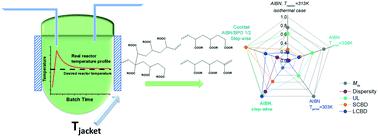当前位置:
X-MOL 学术
›
React. Chem. Eng.
›
论文详情
Our official English website, www.x-mol.net, welcomes your feedback! (Note: you will need to create a separate account there.)
Jacket temperature regulation allowing well-defined non-adiabatic lab-scale solution free radical polymerization of acrylates
Reaction Chemistry & Engineering ( IF 3.9 ) Pub Date : 2021-4-12 , DOI: 10.1039/d1re00099c Mariya Edeleva 1, 2, 3, 4 , Yoshi W. Marien 1, 2, 3, 4 , Paul H. M. Van Steenberge 1, 2, 3, 4 , Dagmar R. D'hooge 1, 2, 3, 4, 5
Reaction Chemistry & Engineering ( IF 3.9 ) Pub Date : 2021-4-12 , DOI: 10.1039/d1re00099c Mariya Edeleva 1, 2, 3, 4 , Yoshi W. Marien 1, 2, 3, 4 , Paul H. M. Van Steenberge 1, 2, 3, 4 , Dagmar R. D'hooge 1, 2, 3, 4, 5
Affiliation

|
Conventional batch solution free radical polymerization (FRP) of n-butyl acrylate (nBuA) with thermal initiators such as 2,2′-azobis(2-methylpropionitrile) (AIBN) is known to be strongly exothermic and influenced by highly activated side reactions such as backbiting and β-scission. However, most FRP kinetic modeling studies are focusing on simplified (theoretical) isothermal conditions and/or are considering only ball-park values for the Arrhenius parameters. In the present work, we overcome these limitations by combining a detailed tree-based kinetic Monte Carlo (kMC) model for radical acrylate polymerization chemistry with an energy balance so that non-isothermal conditions (targeted temperature in range 313–353 K) can be modeled in the presence and absence of jacket temperature modifications. As the reactor size is limited and solution conditions are selected perfect macro-mixing can be assumed but at the micro-scale chain length dependent diffusional limitations on termination need to be accounted for. The inputted Arrhenius parameters all stem from independent experimental techniques (e.g. stepwise pulsed laser polymerization) and the only tuned parameter is the global heat transfer coefficient as determined from a Pyrex 2 L lab-scale reactor. We highlight the relevance of our Arrhenius parameters to reliably predict non-isothermal reactor conditions and demonstrate that safe reactor operation conditions can only be realized by design of the jacket temperature. We utilize both flat profiles and stepwise profiles, including variations in (i) the number of steps and (ii) upward and downward temperature changes. We also put forward that the heat generation rate can be designed by varying the thermal initiator type and considering thermal initiator cocktails. In the end, we tune the batch time, the log-molar mass distribution (MMD) differentiating between unimodal and bimodal shapes, MMD dispersity, unsaturation level, and short/long chain branching density employing industrially relevant conditions. Such conditions lead to a safe reactor operation but remain non-adiabatic, highlighting the future need of non-isothermal polymer reaction engineering models.
中文翻译:

夹套温度调节可实现定义明确的非绝热实验室规模的丙烯酸酯溶液自由基聚合
常规的分批溶液自由基聚合的(FRP)ñ -丁基丙烯酸酯(Ñ已知带有热引发剂(例如2,2'-偶氮二(2-甲基丙腈)(AIBN)的BuA)会放热,并受高度活化的副反应(例如咬合和β断裂)的影响。但是,大多数FRP动力学建模研究都集中在简化的(理论上)等温条件上和/或仅考虑Arrhenius参数的停球值。在当前的工作中,我们通过结合详细的基于树的动力学丙烯酸蒙特卡罗(kMC)模型与自由基丙烯酸酯聚合化学方法进行能量平衡,从而克服了这些局限性,从而可以实现非等温条件(目标温度在313-353 K范围内)在存在和不存在护套温度变化的情况下进行建模。由于反应器的尺寸有限且选择了溶液条件,因此可以假定完美的宏观混合,但是在微米级链长上,需要考虑对终止的扩散限制。输入的Arrhenius参数全部来自独立的实验技术(例如逐步脉冲激光聚合),唯一调整的参数是由Pyrex 2 L实验室规模的反应器确定的总传热系数。我们强调了我们的Arrhenius参数的相关性,以可靠地预测非等温反应堆条件,并证明只有通过设计夹套温度才能实现安全的反应堆运行条件。我们利用平面轮廓和阶梯轮廓,包括(i)步数和(ii)向上和向下温度变化的变化。我们还提出,可以通过改变热引发剂类型并考虑热引发剂混合物来设计发热量。最后,我们调整批处理时间,区分单峰和双峰形状的对数摩尔质量分布(MMD),MMD分散度,不饱和度,以及采用工业相关条件的短/长链支化密度。这样的条件导致安全的反应堆运行,但仍保持绝热,突出了对非等温聚合物反应工程模型的未来需求。
更新日期:2021-04-21
中文翻译:

夹套温度调节可实现定义明确的非绝热实验室规模的丙烯酸酯溶液自由基聚合
常规的分批溶液自由基聚合的(FRP)ñ -丁基丙烯酸酯(Ñ已知带有热引发剂(例如2,2'-偶氮二(2-甲基丙腈)(AIBN)的BuA)会放热,并受高度活化的副反应(例如咬合和β断裂)的影响。但是,大多数FRP动力学建模研究都集中在简化的(理论上)等温条件上和/或仅考虑Arrhenius参数的停球值。在当前的工作中,我们通过结合详细的基于树的动力学丙烯酸蒙特卡罗(kMC)模型与自由基丙烯酸酯聚合化学方法进行能量平衡,从而克服了这些局限性,从而可以实现非等温条件(目标温度在313-353 K范围内)在存在和不存在护套温度变化的情况下进行建模。由于反应器的尺寸有限且选择了溶液条件,因此可以假定完美的宏观混合,但是在微米级链长上,需要考虑对终止的扩散限制。输入的Arrhenius参数全部来自独立的实验技术(例如逐步脉冲激光聚合),唯一调整的参数是由Pyrex 2 L实验室规模的反应器确定的总传热系数。我们强调了我们的Arrhenius参数的相关性,以可靠地预测非等温反应堆条件,并证明只有通过设计夹套温度才能实现安全的反应堆运行条件。我们利用平面轮廓和阶梯轮廓,包括(i)步数和(ii)向上和向下温度变化的变化。我们还提出,可以通过改变热引发剂类型并考虑热引发剂混合物来设计发热量。最后,我们调整批处理时间,区分单峰和双峰形状的对数摩尔质量分布(MMD),MMD分散度,不饱和度,以及采用工业相关条件的短/长链支化密度。这样的条件导致安全的反应堆运行,但仍保持绝热,突出了对非等温聚合物反应工程模型的未来需求。



























 京公网安备 11010802027423号
京公网安备 11010802027423号